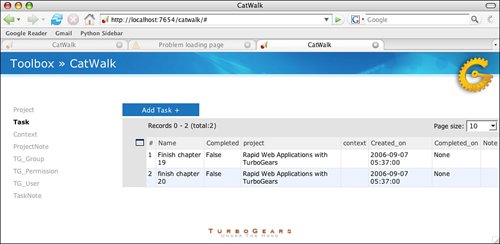Section 19.3. CatWalk
19.3. CatWalkOnce you've created your database schema, you generally need at least a couple records worth of data in order to be able to start writing code and verifying that it works. That's where CatWalk comes in. CatWalk provides an automatically generated GUI for editing sample data during development. The basic editing form, shown in Figure 19.5, is very easy to use for smaller data sets. If this database had a thousand projects in it, the drop-down list would be unmanageable. But, for adding a bit of data into your database during development, it couldn't get much easier than this. Figure 19.5. CatWalk editing The one area that people sometimes get confused about with CatWalk is adding many-to-many join relationships. All you have to do is add the rows to the two tables, edit either of the rows you want to connect, and click the triangle next to the join "column." Then a selection form that lets you manage relationships will appear and you can set up new relationships to your heart's content. In Figure 19.6, you can see another common use of the CatWalk toolbrowsing data. Figure 19.6. Browsing database data There are any number of ways you can customize CatWalk. You can have it display only some fields; you can change the way fields are ordered on your form; and you can even edit what appears in the drop-down lists so that you get actual project names rather than non-intuitive id values. To do this all you have to do is click on the little edit icon in the browse view, and you'll get something like what appears in Figure 19.7. You can uncheck columns to have them not be displayed, or drag-and-drop them to change their order. Figure 19.7. Customizing CatWalk |
EAN: 2147483647
Pages: 202